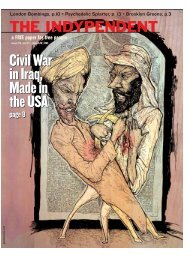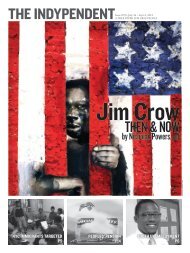Download Issue (pdf) - The Indypendent
Download Issue (pdf) - The Indypendent
Download Issue (pdf) - The Indypendent
You also want an ePaper? Increase the reach of your titles
YUMPU automatically turns print PDFs into web optimized ePapers that Google loves.
haiti<br />
the land so they can be employed in garment<br />
manufacturing in export-processing zones.<br />
To facilitate these zones Collier says, Haiti<br />
and donors need to provide them with private<br />
ports and electricity, “clear and rapid rights to<br />
land;” outsourced customs; “roads, water and<br />
sewage;” and the involvement of the Clinton<br />
Global Initiative to bring in garment manufacturers.<br />
Revealing the connection between neoliberalism<br />
and military occupation in Haiti, Collier<br />
credits the Brazilian-led United Nations<br />
Stabilization Mission in Haiti (MINUSTah)<br />
with establishing “credible security,” but laments<br />
that its remaining mandate is “too short<br />
for investor confidence.” In fact, MINUSTah<br />
has been involved in numerous massacres in<br />
Port-au-Prince slums that are strongholds for<br />
Lavalas. Collier also notes MINUSTah will<br />
cost some $5 billion overall; compare that to<br />
the $379 million the U.S. government has designated<br />
for post-earthquake relief.<br />
Speaking at an October 2009 investors’<br />
conference in Port-au-Prince that attracted dogooders<br />
like Gap, Levi Strauss and Citibank,<br />
Bill Clinton claimed a revitalized garment industry<br />
could create 100,000 jobs. Some 200<br />
companies, half of them garment manufacturers,<br />
attended the conference, drawn by “Haiti’s<br />
extremely low labor costs, comparable to those<br />
in Bangladesh,” <strong>The</strong> New York Times reported.<br />
Those costs are often less than the official<br />
daily minimum wage of $1.75. (<strong>The</strong> Haitian<br />
Parliament approved an increase last May 4<br />
to about $5 an hour, but it was opposed by<br />
the business elite, and President René Préval<br />
refused to sign the bill, effectively killing it.<br />
This episode sparked student protests starting<br />
in June of last year, which were repressed by<br />
Haitian police and MINUSTah.)<br />
ROOTS OF REPRESSION<br />
In his work Haiti State Against Nation:<br />
<strong>The</strong> Origins and Legacy of Duvalierism,<br />
Michel-Rolph Trouillot writes, “Haiti’s<br />
first army saw itself as the offspring of the<br />
struggle against slavery and colonialism.”<br />
That changed during the U.S. occupation of<br />
Haiti from 1915 to 1934. Under the tutelage<br />
of the U.S. Marines, “the Haitian Garde was<br />
specifically created to fight against other Haitians.<br />
It received its baptism of fire in combat<br />
against its countrymen.” This brutal legacy<br />
led Aristide to disband the army in 1995.<br />
Yet prior to the army’s disbandment, in the<br />
wake of the U.S. invasion that returned a politically<br />
handcuffed Aristide to the presidency<br />
in 1994, “CIA agents accompanying U.S.<br />
troops began a new recruitment drive” that<br />
included leaders of the death squad known<br />
as FraPH, according to Peter Hallward, author<br />
of Damning the Flood: Haiti, Aristide<br />
and the Politics of Containment.<br />
It’s worth recalling how the Clinton administration<br />
played a double game under the cover<br />
of humanitarian intervention. Investigative reporter<br />
Allan Nairn revealed that in 1993 “five<br />
to ten thousand” small arms were shipped<br />
from Florida, past the U.S. naval blockade, to<br />
the coup leaders. <strong>The</strong>se weapons enabled<br />
FraPH to grow and to terrorize the popular<br />
movements. <strong>The</strong>n, pointing to intensifying<br />
FraPH violence in 1994, the Clinton administration<br />
pressured Aristide into acquiescing<br />
to a U.S. invasion because FraPH was<br />
becoming “the only game in town.” After<br />
20,000 U.S. troops landed in Haiti, they set<br />
about protecting FraPH members, freeing<br />
them from jail and refusing to disarm them<br />
or seize their weapons caches. FraPH leader<br />
Emmanual Constant told Nairn that after<br />
the invasion the U.S. Defense Intelligence<br />
Agency (DIA) was using FraPH to counter<br />
“subversive activities.” Meanwhile, the State<br />
Department and CIA went about stacking the<br />
Haitian National Police with former army<br />
soldiers, many of whom were on the U.S. payroll.<br />
By 1996, according to one report, Haitian<br />
Army and “FraPH forces remain armed and<br />
present in virtually every community across<br />
the country,” and paramilitaries were “inciting<br />
street violence in an effort to undermine<br />
social order.”<br />
During the early 1990s, a separate group<br />
of Haitian soldiers, including Guy Philippe,<br />
who led the 2004 coup against Aristide, were<br />
spirited away to Ecuador where they allegedly<br />
trained at a “U.S. military facility.” Hallward<br />
describes the second coup as beginning in<br />
2001 as a “Contra war” in the Dominican<br />
Republic with Philippe and former FraPH<br />
commander Jodel Chamblain as leaders. A<br />
Democracy Now! report from April 7, 2004,<br />
claimed that the U.S. government-funded<br />
International Republican Institute provided<br />
arms and technical training to the anti-Aristide<br />
force in the Dominican Republic, while<br />
“200 members of the special forces of the<br />
United States were there in the area training<br />
these so-called rebels.”<br />
A key component of the campaign against<br />
Aristide after he was inaugurated in 2001<br />
was economic destabilization that cut off<br />
funding for “road construction, AIDS programs,<br />
water works and health care.” Likely<br />
factors in the 2004 coup included Aristide’s<br />
public campaign demanding that France<br />
repay the money it extorted from Haiti in<br />
1825 for the former slave colony to buy its<br />
freedom, estimated in 2003 at $21 billion,<br />
and his working with Venezuela, Bolivia<br />
and Cuba to create alternatives to U.S. economic<br />
domination of the region.<br />
When Aristide was finally ousted in February<br />
2004, another round of slaughter ensued,<br />
with 800 bodies dumped in just one week in<br />
March. A 2006 study by the British medical<br />
journal Lancet determined that 8,000 people<br />
were murdered in the capital region during<br />
the first 22 months of the U.S.-backed coup<br />
government and 35,000 women and girls were<br />
raped or sexually assaulted. <strong>The</strong> OPs and Lavalas<br />
militants were decimated, in part by a<br />
U.N. war against the main Lavalas strongholds<br />
in Port-au-Prince’s neighborhoods of Bel<br />
Air and Cité Soleil, the latter a densely packed<br />
slum of some 300,000. (Hallward claims U.S.<br />
Marines were involved in a number of massacres<br />
in areas such as Bel Air in 2004.)<br />
‘MORE FREE TRADE’<br />
Less than four months after the 2004 coup,<br />
reporter Jane Regan described a draft economic<br />
plan, the “Interim Cooperation Framework,”<br />
which “calls for more free trade zones<br />
(FTZs), stresses tourism and export agriculture,<br />
and hints at the eventual privatization<br />
of the country’s state enterprises.” Regan<br />
wrote that the plan was “drawn up by people<br />
nobody elected,” mainly “foreign technicians”<br />
and “institutions like the U.S. Agency<br />
for International Development (USAID) and<br />
the World Bank.”<br />
Much of this plan was implemented under<br />
Préval, who announced in 2007 plans<br />
to privatize the public telephone company,<br />
Téléco. This plan is now being promoted<br />
by Bill Clinton and Ban Ki-moon as Haiti’s<br />
path out of poverty. <strong>The</strong> Wall Street Journal<br />
touted such achievements as “10,000 new<br />
garment industry jobs” in 2009, a “luxury<br />
hotel complex” in the upper-crust neighborhood<br />
of Pétionville and a $55 million investment<br />
by Royal Caribbean International at<br />
its “private Haitian beach paradise.”<br />
Haiti, of course, has been here before, when<br />
the USAID spoke of turning it into the “Taiwan<br />
of the Caribbean.” In the 1980s, under Jean-<br />
Claude “Baby Doc” Duvalier, it shifted onethird<br />
of cultivated land to export crops while<br />
“there were some 240 multinational corporations,<br />
employing between 40,000 and 60,000<br />
predominantly female workers,” sewing garments,<br />
baseballs for Major League Baseball,<br />
and Disney merchandise, according to scholar<br />
Yasmine Shamsie. Those jobs, paying as little<br />
as 11 cents an hour, coincided with a decline<br />
in per capita income and living standards.<br />
(Ban Ki-moon wants Haiti to emulate Bangladesh,<br />
where sweatshops pay as little as 6 cents<br />
an hour.) At such low pay, workers had little<br />
left after purchasing food and transportation<br />
to and from the factories. <strong>The</strong>se self-contained<br />
export-processing zones, often funded by<br />
USAID and the World Bank, also add little to<br />
the national economy, importing tax free virtually<br />
all the materials used.<br />
U.S.-promoted agricultural policies, such<br />
as forcing Haitian rice farmers to compete<br />
against U.S.-subsidized agribusiness, cost<br />
an estimated 830,000 rural jobs according<br />
to Oxfam, while exacerbating malnutrition.<br />
This and the decimation of the invaluable<br />
Creole pig (because of fears of an outbreak<br />
of African swine fever), led to displacement<br />
of the peasantry into urban areas, and along<br />
with the promise of urban jobs, fueled rural<br />
migration into flimsy shantytowns. It’s<br />
hard not to conclude that these development<br />
schemes played a major role in the horrific<br />
death toll in Port-au-Prince.<br />
<strong>The</strong> latest scheme, on hold for now, is<br />
a $50 million “industrial park that would<br />
house roughly 40 manufacturing facilities<br />
and warehouses,” bankrolled by the Soros<br />
Economic Development Fund (yes, that<br />
Soros). <strong>The</strong> planned location is Cité Soleil.<br />
James Dobbins, former special envoy to<br />
Haiti under President Bill Clinton, outlined<br />
other measures in a New York Times op-ed:<br />
“This disaster is an opportunity to accelerate<br />
oft-delayed reforms” including “breaking<br />
up or at least reorganizing the government-controlled<br />
telephone monopoly. <strong>The</strong><br />
same goes with the Education Ministry, the<br />
electric company, the Health Ministry and<br />
the courts.”<br />
It’s clear that the Shock Doctrine is alive<br />
and well in Haiti. But given the strength<br />
of the organisations populaires and weakness<br />
of the government, it will have to be<br />
imposed violently.<br />
For those who wonder why the United States<br />
is so obsessed with controlling a country so<br />
impoverished, devastated, and seemingly inconsequential<br />
as Haiti, Noam Chomsky sums<br />
it up best: “Why was the U.S. so intent on destroying<br />
northern Laos, so poor that peasants<br />
hardly even knew they were in Laos Or Indochina<br />
Or Guatemala Or Maurice Bishop in<br />
Grenada, the nutmeg capital of the world <strong>The</strong><br />
reasons are about the same, and are explained<br />
in the internal record. <strong>The</strong>se are ‘viruses’ that<br />
might ‘infect others’ with the dangerous idea<br />
of pursuing similar paths to independent development.<br />
<strong>The</strong> smaller and weaker they are,<br />
the more dangerous they tend to be. If they<br />
can do it, why can’t we Does the Godfather<br />
allow a small storekeeper to get away with not<br />
paying protection money”<br />
<strong>The</strong> <strong>Indypendent</strong> February 19 – March 11, 2010 13












